
The 29th Infantry Division, also known as the "Blue and Gray Division", is an infantry division of the United States Army based at Fort Belvoir in Fairfax County, Virginia. The division is currently a formation of the Army National Guard and includes units from Virginia, Maryland, Kentucky, North Carolina, South Carolina, and West Virginia.

The 37th Infantry Division was a unit of the United States Army in World War I and World War II. It was a National Guard division from Ohio, nicknamed the "Buckeye Division". Today, its lineage is continued through the 37th Infantry Brigade Combat Team, with battalions from Ohio, Michigan, and South Carolina.

The 30th Infantry Division was a unit of the Army National Guard in World War I and World War II. It was nicknamed the "Old Hickory" division, in honor of President Andrew Jackson. The Germans nicknamed this division "Roosevelt's SS". The 30th Infantry Division was regarded by a team of historians led by S.L.A. Marshall as the number one American infantry division in the European Theater of Operations (ETO), involved in 282 days of intense combat over a period from June 1944 through April 1945. In the present day, the division's lineage continues as 30th Armored Brigade Combat Team, part of the North Carolina National Guard. The unit's most recent combat deployment was in 2019.
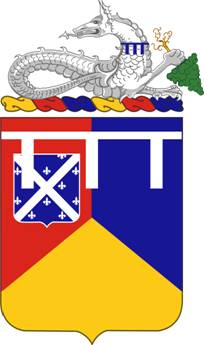
The 66th Armor Regiment is the oldest armored unit in the United States Army, tracing its lineage to the 301st Tank Battalion which served with distinction soon after it was formed in the First World War; the 301st trained at Camp Meade, Maryland, where then-Cpt. Dwight D. Eisenhower was an instructor. It has often been rumored that the 301st, the parent unit of the 66th, was first commanded by Col. George S. Patton, but this appears not to have been the case; while Patton was the first officer assigned to the Tank Corps, and while the 301st Tank Battalion was the first unit formed, Patton went nearly immediately to France to train Americans attached to Allied commands. The 301st was the only American heavy tank battalion to have seen action in the war. After the war, the 301st transitioned in the Regular Army to become the 66th Infantry Regiment by way of the 16th Tank Battalion.

The Pennsylvania Army National Guard, abbreviated PAARNG, is part of the United States Army National Guard and is based in the U.S. Commonwealth of Pennsylvania. Together with the Pennsylvania Air National Guard, it is directed by the Pennsylvania Department of Military and Veterans Affairs. The PAARNG maintains 124 armories and is present in 87 communities across the Commonwealth.

The 112th Infantry Regiment, also known as the Sixteenth Pennsylvania, is a unit in the Pennsylvania National Guard which can trace its lineage back to before the American Civil War.

The 158th Infantry Brigade is an infantry brigade of the United States Army. It has subordinate battalions throughout Florida and Puerto Rico.

The 157th Infantry Brigade is an active/reserve component (AC/RC) unit based at Camp Atterbury, Indiana. The unit is responsible for training selected United States Army Reserve and National Guard units. The unit was activated using the assets of the 5th Brigade, 87th Division. The brigade is a subordinate unit of First Army Division East.
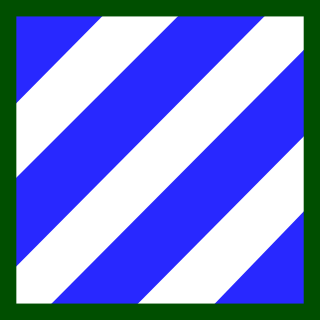
The 48th Infantry Brigade Combat Team is a modular infantry brigade of the Georgia Army National Guard. One of the oldest units in U.S. Army history, the lineage of the 48th Infantry Brigade can be traced back to 1825. It is one of few units in the US military that also saw service as a unit of the Confederate States of America during the American Civil War. Today, the 48th IBCT is part of the U.S. Army's "Associated Units" program where it is aligned under the 3rd Infantry Division, a combined arms combat maneuver unit of the Regular Army.
The 67th Armored Regiment is an armored regiment in the United States Army. The regiment was first formed in 1929 in the Regular Army as the 2nd Tank Regiment (Heavy) and redesignated as the 67th Infantry Regiment (Medium Tanks) in 1932. It first became the 67th Armor in 1940. The regiment participated in World War I, World War II, Desert Storm/Desert Shield, Operation Iraqi Freedom, Operation Enduring Freedom, Operation Spartan Shield, Operation Inherent Resolve, Operation Resolute Support, and Operation Freedom's Sentinel.

The 6th Field Artillery Regiment is a Field Artillery Branch regiment of the United States Army first activated in 1907 from numbered companies of artillery. It was first organized with two battalions.

The 33rd Field Artillery Regiment is an inactive field artillery regiment of the United States Army, first constituted in 1918 in the National Army (USA). A parent regiment under the U.S. Army Regimental System, the regiment has no active regiments. The regiment saw active service with the 1st Infantry Division in World War II. The regiment's 2nd and 6th Battalions served in Vietnam.

The 102nd Cavalry Regiment is a regiment of the United States Army first established in 1913 and which saw service in World War II.
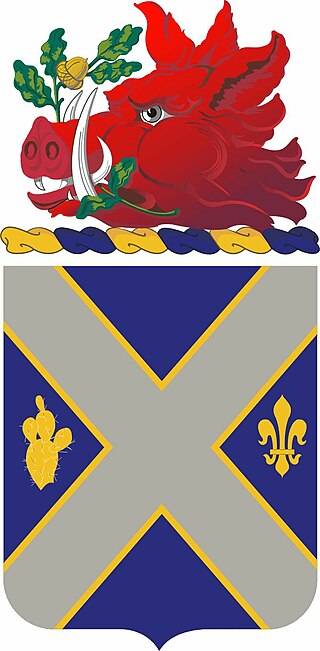
The 121st Infantry Regiment is an infantry regiment of the Georgia National Guard that saw combat service in the First and Second World Wars. As a result of army-wide reorganization in the 1950s, the 121st Infantry ceased to exist as a single unit; today, various units of the Georgia National Guard trace their lineage to the 121st Infantry.
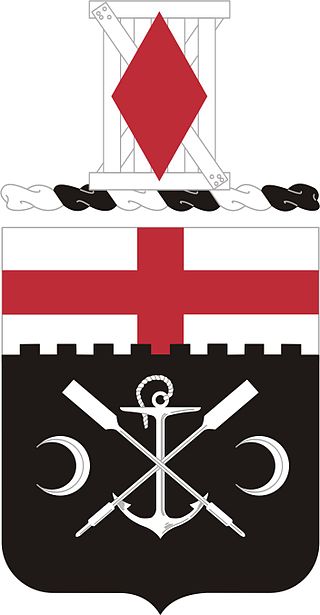
The 7th Engineer Battalion is a unit of the United States Army located at Fort Drum, New York. This battalion falls under the 10th Mountain Division's 1st Brigade Combat Team. The battalion has the Brigade Combat Team's engineer companies, military intelligence company, and signal company.

The 112th Field Artillery Regiment is a Field Artillery Branch regiment of the New Jersey Army National Guard first formed in April 1917. In December 1941, it was the last field artillery regiment in the U.S. Army to convert from horse-drawn to truck-drawn howitzers.
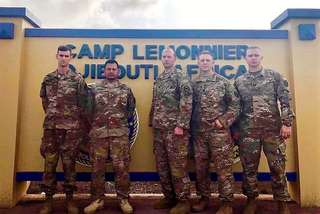
The 110th Information Operations (IO) Battalion was federally recognized as an organization on April 1, 2008. Following the inactivation of the 2d Battalion, 110th Field Artillery Regiment, the 110th IO battalion was given the honor to carry the 2d Battalion 110th Field Artillery lineage which dates back to World War I. The 110th IO FSB was designed to provide trained, deployable, culturally aware, and regionally focused information operations teams to perform tactical strategic-theater IO tasks.

















